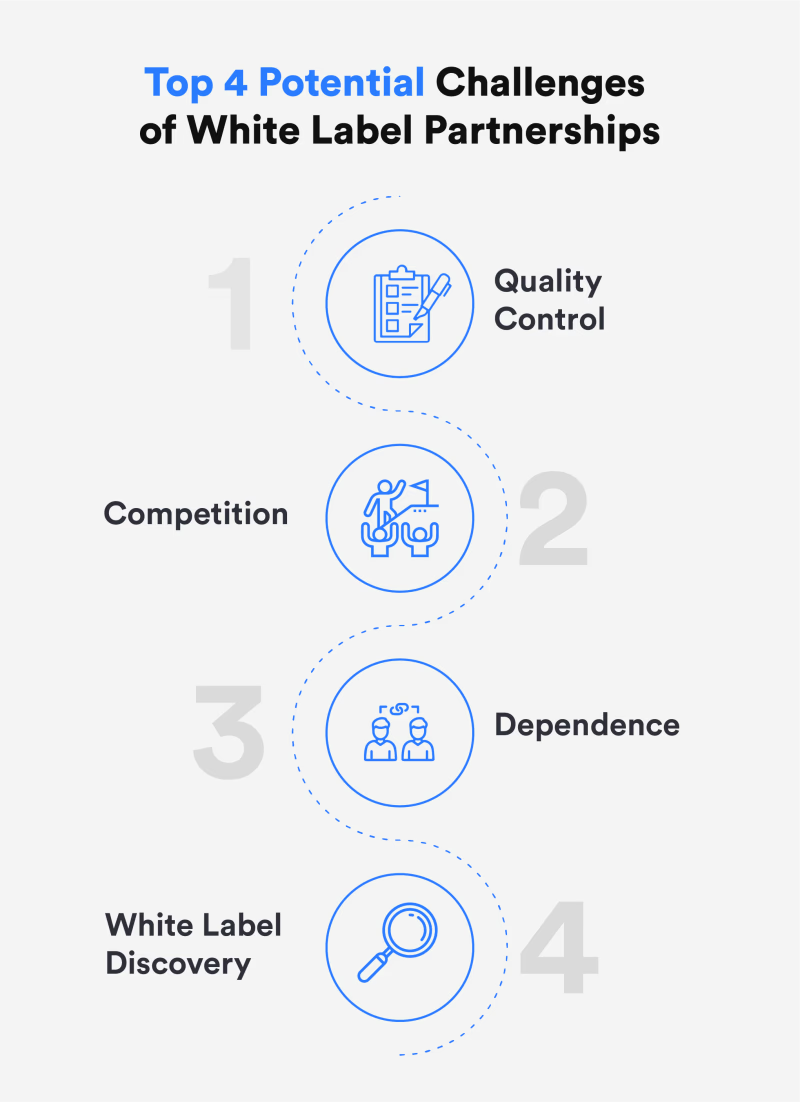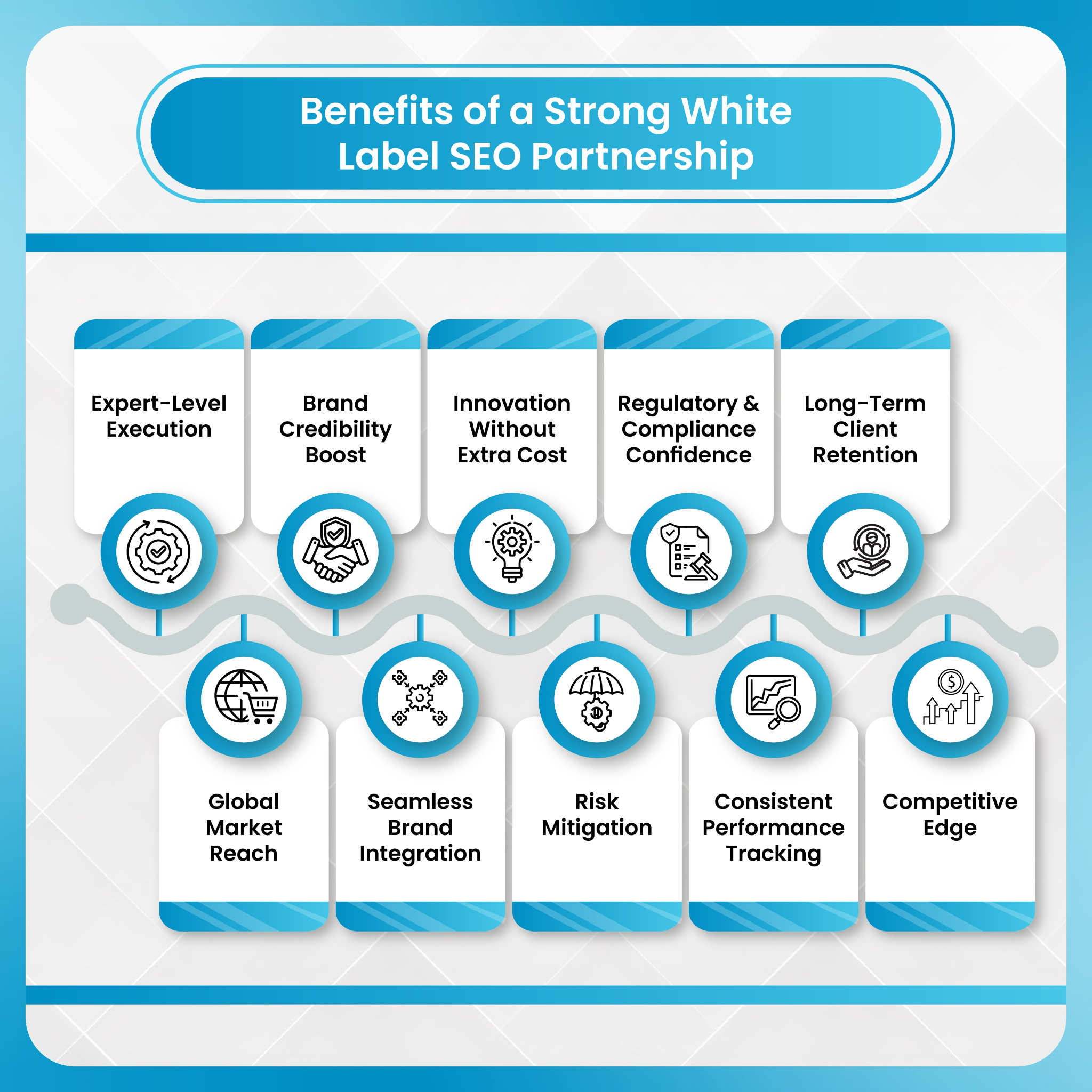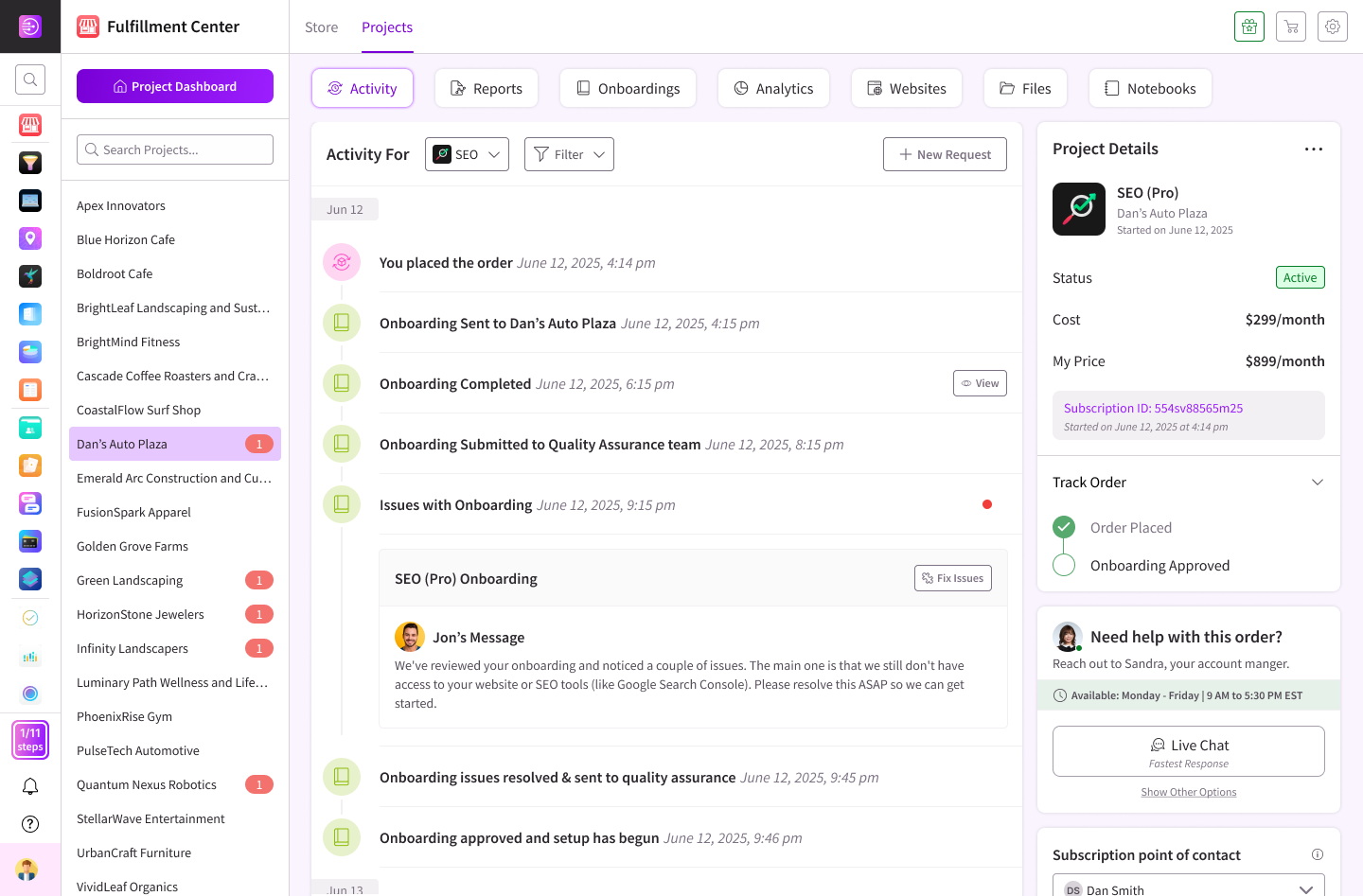Outsourcing to a white label SEO agency can feel like a huge leap of faith. You’re entrusting a critical part of your clients’ success to an external partner, and the pressure is on to ensure they deliver. But how do you verify their work and maintain quality without hovering over their shoulder like a helicopter boss?
The challenge is real: you need oversight to guarantee results, but micromanaging can destroy trust, slow down processes, and strain your partnership. It’s a delicate balancing act. In fact, an SEMrush Agency Report found that over 60% of agencies face challenges maintaining SEO quality with their outsourced partners.
So, how do you strike the perfect balance? This guide will walk you through auditing your white label SEO partner’s work effectively, ensuring accountability and top-tier results without the friction of micromanagement.
What to Audit in a White Label SEO Partner’s Work?
Before diving into the "how," it's essential to understand "what" you should be auditing. A comprehensive audit isn't about checking every single action but rather verifying the key pillars of a successful SEO campaign. Focus on these core areas:
- Deliverable Verification: The most basic check is to confirm that the work you paid for was actually completed. This includes the promised number of blog posts, meta tag optimizations, technical fixes, and backlinks built. If your agreement specifies 2,000 words of content and 5 backlinks per month, your first step is to ensure those deliverables are present.
- Process Compliance: A good white label SEO partner will have clear Standard Operating Procedures (SOPs). Your audit should confirm they are following the agreed-upon methodology. Are they using the approved content creation workflow? Is their link-building outreach aligned with your agency’s standards? Consistency in process often leads to consistency in results.
- Strategic Alignment: SEO tactics should never exist in a vacuum. A crucial part of your audit is to ensure the partner’s work aligns with your client’s specific goals, industry, and target audience. For example, if the client is a local bakery, the strategy should be heavily focused on local SEO, not broad, international keywords.
- Reporting Accuracy: The numbers don't lie—or at least, they shouldn't. Scrutinize the dashboards and reports provided by your partner. Do the reported traffic increases match what you see in Google Analytics? Do the backlinks they claim to have built actually exist, and are they indexed? Verifying the data is fundamental to trusting the results.
- Sample Spot-Checks: You don’t need to audit every single piece of work. Instead, implement a system of spot-checking. By reviewing a small, random sample—say, 10% of the month's deliverables—you can get a reliable sense of the overall quality and adherence to standards without getting bogged down in minutiae.
Red Flags in White Label SEO Performance
While trust is important, it’s equally important to be vigilant. Certain red flags can signal that your white label SEO services partner isn’t performing as expected. Catching these early can save you from client dissatisfaction and wasted budgets.
Here are some common warning signs:
- Incomplete or Inconsistent Deliverables: Your partner consistently misses deadlines, delivers fewer articles than promised, or the quality of their work varies wildly from one week to the next.
- One-Size-Fits-All Strategies: You notice they are applying the exact template of keywords and content ideas across all your clients, regardless of their unique business needs or industry.
- Uneven Technical Fixes: They claim to have optimized a client’s site speed, but you find that only the homepage loads quickly, while other critical pages remain sluggish.
- Poor Communication: Delays happen, but a good partner communicates them proactively. If you’re constantly chasing them for updates, it’s a major red flag.
- Resistance to Feedback: When you provide constructive criticism, they become defensive or fail to implement the suggested changes in future work.
- Inaccurate or Inflated Reporting: This is a cardinal sin. They might report backlinks from non-existent or low-quality spam sites, or show traffic spikes that are clearly from bot activity.
- Over-Reliance on Automation: While tools are essential, an over-reliance on SEO automation without human oversight can lead to generic, low-quality content and spammy link-building practices.
- High Staff Turnover: If you’re dealing with a new account manager every few months, it can disrupt communication and lead to a loss of strategic momentum.
- Dashboard and Integration Issues: Consistent problems with their reporting dashboard or a refusal to integrate with your agency’s tools can be a sign that they are trying to obscure poor performance.
Recognizing these red flags is the first step. The next is knowing how to address them without creating a high-friction in the agency-client relationship.

How to Audit Without Micromanaging?
The key to effective auditing is to build a system of accountability that operates on trust and transparency. It’s about setting clear expectations and then using streamlined processes to verify them. Here’s how you can achieve this:
1. Define KPIs and SLAs Upfront
Before you even begin working together, establish clear Key Performance Indicators (KPIs) and a Service Level Agreement (SLA). These documents should leave no room for ambiguity.
- KPIs might include targets for organic traffic growth, keyword ranking improvements, and conversion rates.
- SLAs should define the specifics: deliverable deadlines, reporting frequency, and communication response times.
When everyone knows what success looks like, it’s much easier to measure performance objectively.
2. Use Checklists and Spot-Checks
Create simple checklists for each type of deliverable. For a blog post, this might include checking for target keyword usage, internal links, and meta description optimization. For link-building, it could be domain authority, relevance, and anchor text.
Then, use these checklists to perform spot-checks on a small percentage of the work. For example, audit 10% of new content and 1-2 technical fixes each week. This approach is efficient and gives you a solid snapshot of quality without reviewing every single item.
3. Leverage a Centralized Dashboard
A shared dashboard like DashClicks' white label dashboard software is your best friend for oversight without micromanagement. The client dashboard feature tracks project timelines, task completion, and key milestones. You can get a high-level view of progress at a glance, drilling down into specifics only when necessary. This eliminates the need for constant "just checking in" emails.
4. Schedule Regular Strategic Reviews
Instead of daily check-ins, schedule monthly or quarterly strategic review meetings. Use this time to discuss high-level performance, review progress against KPIs, and align on the strategy for the upcoming period. These meetings foster a collaborative spirit and keep the focus on big-picture goals rather than minor day-to-day tasks.
5. Establish Clear Feedback Loops
Create a formal, constructive system for providing feedback. This could be a shared document where you note observations from your spot-checks. Frame your feedback positively, focusing on improvement. For instance, instead of saying, "This content is bad," try, "For the next batch of articles, let's aim to include more data points to strengthen our arguments."
6. Use Automation and Alerts
Set up automated alerts for critical issues. You can use tools to notify you of missed deadlines, broken links on a client’s site, or significant drops in keyword rankings. This allows you to stay informed about major problems without having to manually monitor everything all the time.
By implementing these systems, you create a framework where your partner has the autonomy to do their best work, while you retain the oversight needed to ensure quality and protect your clients' interests.
Corrective Actions When Issues Arise
Even with the best systems, you may occasionally uncover challenges.

Image Source: WotNot
Recognizing these challenges is the first step. Once identified, structured corrective actions ensure the partnership remains productive and aligned with client goals.
How you handle these situations is what defines the strength of your partnership. The goal is to correct the problem and prevent it from happening again, not to assign blame.
- Communicate Gaps Professionally: When your audit reveals a problem, address it with your partner directly and professionally. Use data from your audit to illustrate the issue. For example, "Our spot-check of this month's backlinks found that 3 out of 5 links were from sites with a Domain Authority under 10, which is below the standard we agreed on in our SLA."
- Adjust Workflows or SOPs: Often, issues are a result of a flawed process, not a lack of effort. Work collaboratively with your partner to adjust the SOPs to prevent a recurrence. If link quality is the issue, you might add a pre-approval step for all domains before outreach begins.
- Realign on Client Goals: Sometimes a partner’s work is technically fine but strategically misaligned. Revisit the client’s core objectives. A quick conversation can often get things back on track. "Remember, this client's main goal is to drive foot traffic, so let's ensure our content strategy is heavily focused on local keywords and topics."
- Document Learnings: Treat every issue as a learning opportunity. Document the problem, the solution, and any process changes in a shared knowledge base. This documentation helps reduce the need for future micromanagement by creating a clear precedent for how to handle similar situations.
Best Practices for Long-Term Partner Oversight
A successful partnership with a white label SEO agency is built over time. It requires a foundation of trust, clear communication, and well-defined systems. Here are some best practices to ensure a healthy and productive long-term relationship:
- Maintain Structured Reporting Templates: Use consistent reporting templates for all clients and all partners. This makes it easy to compare performance and spot anomalies quickly.
- Define Clear Ownership: While you want to avoid daily supervision, there should be no ambiguity about who is accountable for what. Define clear roles and responsibilities from the outset.
- Encourage Partner Education: The world of SEO is always changing. Encourage your partner to stay updated on the latest trends and algorithm updates. Share client-specific nuances and industry news to help them create more effective, tailored strategies.
- Foster Trust-Based Collaboration: Ultimately, the goal is to build a relationship where you trust your partner to deliver. This trust is earned through consistent performance and transparent communication. Your audit system should serve as a safety net, not a tool for suspicion.
A study published in the ISACA Journal (2024) discusses how adopting agile methodologies in internal auditing can enhance employee engagement. The research indicates that agile auditing approaches actively promote collaboration and engagement, incorporating cross-functional teams and stakeholders throughout the audit process.

How DashClicks’ White Label Facebook Ads Can Help?
Managing SEO for multiple clients can quickly become overwhelming. From keyword tracking and backlink audits to content optimization and reporting, the workload adds up fast—especially if you’re doing it all manually or across multiple tools. That’s where a reliable white label SEO services provider like DashClicks makes a difference.
DashClicks provides agencies with a complete suite of SEO tools built to simplify campaign management and reporting. Through its centralized dashboard, you can:
- Track keyword rankings and organic traffic for all clients in one place.
- Run detailed site audits to identify technical and on-page issues.
- Monitor backlinks and identify opportunities for link-building.
- Generate branded, easy-to-read SEO reports that clients can access anytime.
Everything is designed to run under your own agency’s branding, so you maintain a professional image while DashClicks does the heavy lifting behind the scenes.
By using DashClicks’ white label SEO services, you can scale your agency’s SEO offerings without hiring extra staff or worrying about quality control. The platform ensures accuracy, consistency, and transparency—helping you deliver measurable results while keeping your clients informed and confident in your work.
Conclusion
Auditing your white label SEO partner doesn't have to be a battle between oversight and autonomy. By establishing clear expectations, using systematic spot-checks, and fostering open communication, you can ensure high-quality SEO delivery for your clients without falling into the trap of micromanagement.
This balanced approach not only leads to better results and improved client satisfaction but also builds a stronger, more resilient partnership. It allows you to scale your agency with confidence, knowing you have a reliable system in place to maintain quality and drive growth.



.svg)

.svg)
.svg)
.svg)
.svg)
.svg)

.svg)




.svg)
.svg)
.svg)
.svg)
.svg)